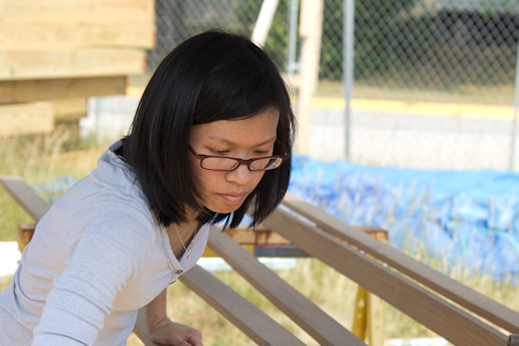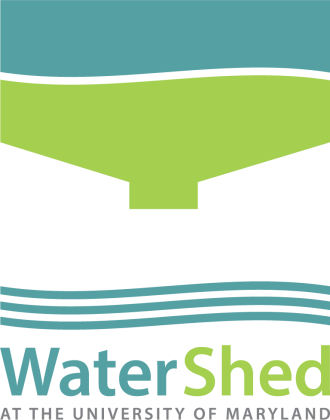
Lynn Khuu, Team Leader, Working on Site
Photo Credit: Aditya Gaddam
One of the most amazing aspects of WaterShed is that the beautiful structure soon to be on display on the National Mall once resided simply on a piece of paper; an idea sprung from the collective creativity and ingenuity of a handful of students. One of those students is Lynn Khuu.
Lynn, who received the Master of Architecture degree this past spring, started her WaterShed odyssey in the spring of 2010 during a topical studio, as part of the master program. There she and a group of dedicated peers researched, sketched, and designed the concept proposal that nabbed them one of the 20 coveted entries into this year’s decathlon. Since then, Lynn has dedicated herself to various aspects of team communications and sponsorship, including outreach, public exhibit materials, and the website. Below Lynn talks about the rewards of the process and the importance of water conservation.
What has been your personal WaterShed moment so far?
LK: I think it’s seeing the whole design process in action and challenging innovation. It’s not everyday a student or young professional is exposed to all the different responsibilities and parts of the process in a single project. The whole project is organized yet chaotic at the same time. Everyone is wearing a number of different hats and we’re all learning together. And through the process, it’s great to see how a design concept has developed through the labor of several semesters to become this very tangible and inhabitable home.
Talk about an unexpected, amazing, frightening, or unlikely experience while working on WaterShed:
LK: I don’t think this qualifies for any of the above, but at one point while driving, I considered stopping on the side of the road to take pictures of grasses for a rendering. Not too sure where my mind was.
On a serious note though, I really admire the team’s drive and dedication (even as teammates are always joking around). I remember everyone being stranded at home due to a blizzard prior to the concept design submittal. We somehow found our way onto skype for studio and trekked our way to the architecture building over the weekend. There is always an overwhelming amount of work to be done and pulling together and a “can do” attitude goes a long way.
What has been your most important learning experience on the project?
LK: It’s sort of difficult to say. Every part of the project offers an invaluable educational experience. I think the top ones for me are interdisciplinary teamwork and the opportunity of being thrust into new or different roles/situations that you may not experience otherwise. It’s a chance to step into another person’s shoes and see things from different perspectives.
Has working on WaterShed personally affected the way you use water?
LK: Definitely. It’s one of those things where once you’ve learned the facts and realize the impact of water on your life, it’s difficult to not try to do anything about it. It’s not that I didn’t try to conserve water before becoming involved with this project, but working on WaterShed has made me more conscientious of design decisions and daily activities. It’s inspired me to be more thoughtful about ways water could be conserved or reused – for instance, collecting water from a dehumidifier to water plants instead of pouring it down the drain and later turning on the hose outside to water the plants. And strangely, it bothers me whenever I see people running the sprinkler (especially if they’re watering the sidewalk) or irrigating plants around mid-day now; I just want to ask them to turn off the water until it’s cooler out.
Has working on WaterShed influenced your career path?
LK: I don’t know that it has changed my career path, but it has certainly reinforced my interest in sustainable design. I’ve always felt sustainability should be intuitive to the design process and creation of the built environment and it’s certainly something I continue to strive for.
When people come to visit WaterShed on the Mall in September, what do you hope they will take away from the experience?
LK: I simply hope visitors feel inspired. Living sustainably doesn’t have to be difficult and if our design can provoke people to question the way they live, demonstrate everyday applicability, and influence a person to make one small change, we are all one step closer to addressing the growing environmental issues we face.
How do you spend your free time when you’re not on the job site?
LK: Free time? What’s that? I feel awful that I haven’t spent much time with family and friends over the past few years as the result/combination of school, thesis, and working on this project, so I try to find time to see them. I also have a lot of cleaning to do that I’ve yet to touch. It’s like an explosion of paper and projects in the basement.
